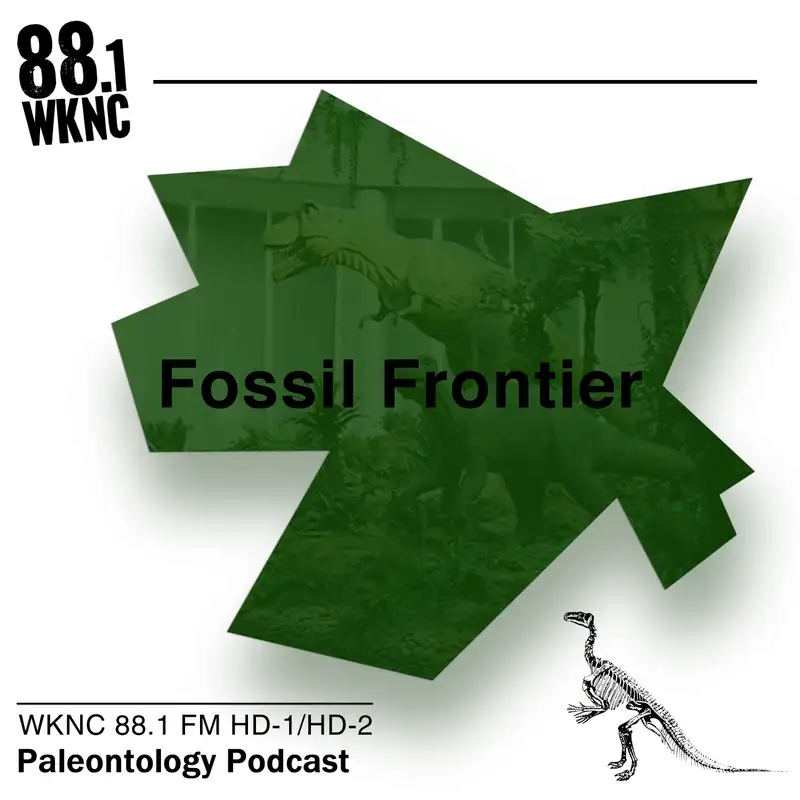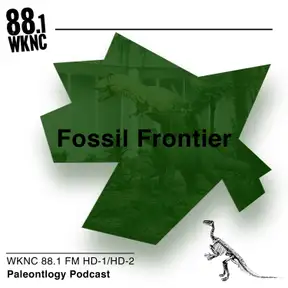Patagotitan: The Biggest Dinosaur?
Download MP3Scrimble 0:00
Music. Hello everybody. I'm Scrimble and welcome to the ninth episode of my podcast, fossil frontier, a paleontology podcast brought to you by wknc 88.1
this show will be dedicated to talking about my favorite fossils and prehistoric phenomena. We're gonna explore some of Earth's ancient treasures and uncover the stories that they have to tell. So if that's something you're into, you better lock in, because this week we're talking about the patagotitan, the largest dinosaur and largest land animal to ever live.
Okay, So picture this yo Aurelio Hernandez, a farm worker in La Flecha, Argentina, in 2010 as you punch in to go to work and make your way onto the field, you spot something odd in the distance. Something is poking out of the soil. As you come closer, the object just keeps getting bigger and bigger in your view, until you come upon it to find that it's a massive dinosaur bone, a femur bigger than you've ever seen before, even in museums. So you report your finding to the Museum of paleontology Egidio Feruglio and they do multiple expeditions between 2012 and 2015
where they discover the fossils of six adult sauropods. These are the long necked herbivore dinosaurs. Because of their size and unique vertebrae, they are also classified into the clade titanosaura. And Titan is a very fitting word here, because these guys are estimated to have been over 120
feet long and 150,000
pounds. That's about two semi trucks in length and a water Tower's worth of weight. But anyways, after the fossils were excavated and classified, the species was given the name padago Titan maorum.
So how did these dinosaurs get so huge, and what did their life look like when they were alive, over 100 million years ago?
So the patagotitan, along with many other similar titanosaurs, lived in South America in heavily planted regions. This was good because they were strict vegetarians with teeth specially designed to grind up plant matter during the Cretaceous period when they lived, they were mostly ferns and conifers for them to snack on. Their size helped them reach higher plants and travel longer distances to find food, which became an evolutionary advantage that they utilized to its extreme. They also notably traveled in herds likely to ward off predators. You heard that right, even the biggest land animal to ever exist still had to worry about predators, while their size definitely played a part in keeping them safe. Ultimately, they were lovers, not fighters, so they probably saw the losing end in a fight with a predator more than once, which may be how the individuals found in Argentina met their demise. But the interesting thing about these six dinosaurs that were found in the excavation is that upon further research, it was discovered that they all died at different times, and while the area was once a floodplain, the water was not strong enough to move the bodies. It's also important to note that all six patago Titans were very similar in size, only differing by about 5%
so there were six patagotitans all the same age, dying in the same spot at different times. But the question is, why? What were these massive titanosaurs up to where they all died in the same place around the same time in their lifespan?
Well, unfortunately, no one knows for sure, but one of the most prominent theories is that the floodplain was along their migratory pathway, and predators would camp out and wait for them there to ambush them. This would account for the location, but not why they were all the same size. Perhaps that's just one of life's ancient mysteries that will never be solved,
and with that, there's actually another puzzle that's still being hotly debated today regarding the patagotitan, because many scientists argue that it actually wasn't the biggest dinosaur ever you see in terms of other fossils that we've studied, the argentiniosaurus, another Titanosaur from South America, may just give it a run for its money. Paleontologists determined that they were of comparable size, but they're unable to say for sure which one was bigger, because there simply aren't enough fossils to really compare both. And speaking of incomplete fossil records, there are some dinosaurs we know even.
Less about which could be candidates for the biggest First, there's the broome sandstone track maker, whose only surviving remnant is a single track mark from Australia. But with this information, we know that these guys could have been about 160,000
pounds. Then there's also the brahath chaosaurus, which is known only from photos of a singular bone and could have been about 180,000
pounds. Unfortunately, there just isn't enough information to say which one was the biggest. And new fossils are being discovered all the time. But for now, with the information we have today, I will say that the patago Titan was the largest.
And at the end of the day, we can argue the details of each dinosaur, but it's important to take a step back and remember how astonishing these guys actually are. It's hard to visualize the immense size of the patagotitan just by talking about them, which is why going to museums and seeing these fossils, or at least replicas of them in person, is so important. One of my favorite exhibitions of the patago Titan, and the reason why they're my personal favorite dinosaur all time, was at the American Museum of Natural History in New York City because the fossil was too large to fit in the Miriam and Ira D Wallach orientation center, they actually positioned this beautiful dinosaur so the neck stretches out the door to the elevator banks greeting visitors as they Come in. It truly was a sight to see.
But ultimately, this display showed off the biggest dinosaur to ever live, while their fossil record is sparse, it shows how these guys would migrate long distances to find food, and could reach even the highest treetops. The context around how they all ended up in the same location 100 million years ago may remain a mystery, but the fact that they existed at all is a true testament to the wonders of the ancient world and the scientists tireless research and eventual display of the patagotitan mayorum Just goes to show how important it is not only to view the remains of these massive creatures yourself, but also to support your local museums and science centers who display countless other artifacts from the prehistoric and modern world. Because to truly grasp the complexity and astonishment of ancient animals, not just the patagotitan, you just need to see them for yourself.
Thank you for listening to the ninth episode of fossil frontier. This has been a wknc podcast. Good night, and I love you.
The audio used in this podcast was Song Thresh nature, field recording, garden atmo, recorded by Garuda 1982 under creative commons license in.
Transcribed by https://otter.ai

